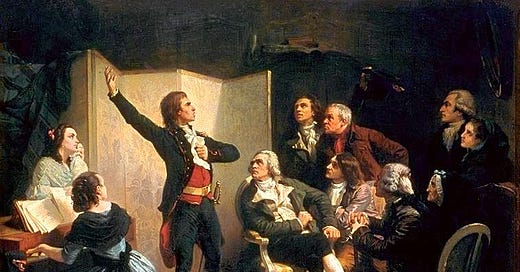A Revolutionary Anthem: The Story of La Marseillaise
The fascinating story of a song that began as a war cry — and became the soul of a republic.
Bonjour!
This is the second article in my Substack series on the national symbols of the French Republic, counting down to Bastille Day.
If you're not yet a paying subscriber, you're currently reading the free introduction.
To read the full story of this remarkable anthem—its birth, its blood, and its ongoing legacy—consider joining us as a paid member. Merci beaucoup!
A different kind of patriotism
If you grew up in France like I did, chances are La Marseillaise was drilled into your memory before you understood half of it.
We sang it in school. We stood upright and serious on commemorative days. We saw politicians stand stiffly to its notes on the evening news.
But it didn’t always stir the heart.
It wasn’t until I left France that I realised how strange, how visceral, the anthem actually is.
When you live abroad, you get used to hearing other anthems — slow, stately, proud.
The British God Save the King, the uplifting Australian Advance Australia Fair, the melodic Italian Fratelli d’Italia. Most of them sound ceremonial. Majestic. Safe
And then there's La Marseillaise.
It doesn’t gently evoke national pride. It punches you in the gut.
The music: a revolution in sound
What people often overlook is how musically bold the anthem is.
Unlike most 18th-century compositions written for courts and salons, La Marseillaise surges forward like a cavalry charge. The melody is built for mass appeal — martial but singable, emotional but structured.
It uses a march-like 4/4 rhythm that’s easy to follow but full of dramatic leaps and passionate dynamics. It was made to be sung in unison, shouted in the streets, echoed across battlefields.
Rouget de Lisle, despite not being a professional composer, managed to fuse the military and the lyrical.
That’s a rare thing — and it explains why the song spread so quickly through France and beyond.
From Strasbourg to Paris via Marseille: the birth of a revolutionary anthem
The year was 1792.
France was at war — not just with foreign monarchies, but with itself.
The Revolution had already shaken the kingdom to its foundations, and now Austria had declared its intent to crush it.
In this charged atmosphere, Baron de Dietrich, the mayor of Strasbourg, asked one of his dinner guests — an officer named Claude-Joseph Rouget de Lisle — to compose a war song.
Something that would rouse the troops. Rally the people. Set fire to the soul.
Rouget de Lisle was not a radical. In fact, he was a royalist at heart. But he was also a soldier, and a musician. That night, in his small room on Rue de la Mésange, he wrote the Chant de guerre pour l’Armée du Rhin — the “War Song for the Army of the Rhine”.
Legend has it he composed both lyrics and melody in a single sitting, pouring out verse after verse as cannonfire echoed in the distance.
Was it divine inspiration?
Was it desperation?
Or simply the right man, in the right city, at the right moment in history?
Whatever it was, it worked.
Keep reading with a 7-day free trial
Subscribe to French Moments Newsletter to keep reading this post and get 7 days of free access to the full post archives.






